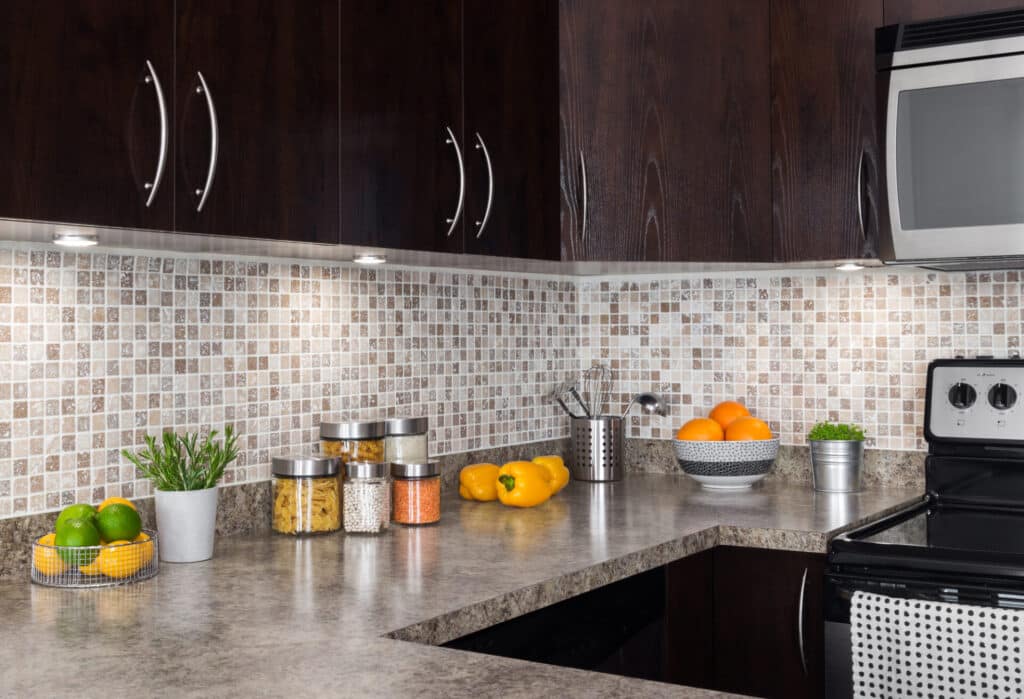
The kitchen is often considered the heart of the home, and homeowners are always looking for ways to add style and functionality to this important space. One popular way to enhance the kitchen’s aesthetic appeal is by installing a backsplash. Not only does a backsplash provide protection to the walls behind the sink and stove from splatters and spills, but it also adds a decorative element to the kitchen design.
If you’re considering installing a kitchen backsplash, you might be wondering about the cost involved. In this article, we will explore the factors that affect the cost of a kitchen backsplash installation and provide you with a comprehensive understanding of the expenses involved in this project.
Factors Affecting the Cost of a Kitchen Backsplash
The cost of installing a kitchen backsplash can vary significantly based on several factors. To be able to have a clear idea of how much your backsplash installation might cost, it’s crucial to understand these factors. Let’s delve into each of them in detail.
1. Material
The material you choose for your kitchen backsplash plays a significant role in the overall cost. Backsplash materials vary widely in terms of price, ranging from affordable options to high-end choices. Here are some popular backsplash materials and their approximate costs per square foot:
a. Ceramic Tiles: Ceramic tiles are a budget-friendly option, with costs ranging from $1 to $20 per square foot. The price depends on factors such as the quality of the tiles, pattern, and manufacturer.
b. Subway Tiles: Subway tiles are a classic choice, often used to create a timeless look in the kitchen. They typically cost between $2 and $30 per square foot, depending on factors like quality, color, and design.
c. Glass Tiles: Glass tiles can add a modern and sleek touch to your backsplash. They come in a variety of colors and styles, and their prices generally range from $7 to $30 per square foot.
d. Natural Stone: Natural stones such as marble, granite, or travertine can create an elegant and luxurious backsplash. However, the prices vary significantly depending on the specific type of stone you choose. On average, natural stone backsplashes cost between $15 and $40 per square foot.
e. Metal Tiles: Metal tiles, such as stainless steel or copper, can give your kitchen a contemporary and industrial look. They usually cost between $20 and $50 per square foot.
f. Mosaic Tiles: Mosaic tiles consist of small, intricate patterns or designs. They can be made from a variety of materials, including glass, ceramic, or stone. Mosaic tiles are generally priced between $10 and $100 per square foot, depending on the complexity of the design and materials used.
2. Backsplash Size
The size of your backsplash area will directly impact the cost of the installation. The total square footage of the backsplash will determine the amount of material you need and the labor required. You can calculate the size by measuring the length and height of the area you plan to install the backsplash.
To be able to get an accurate estimate of the size, it’s advisable to consult with a professional installer or Santa Rosa general contractor who can measure the area precisely. This way, you can avoid underestimating or overestimating the amount of material needed and optimize your budget accordingly.
3. Labor Costs
The labor cost for installing a kitchen backsplash can vary depending on your location, the complexity of the project, and the experience level of the kitchen remodel contractor or installer. Most professionals charge either an hourly rate or a flat fee for the entire project.
On average, labor costs for backsplash installation can range from $30 to $90 per hour. However, some installers may have a minimum fee or charge a percentage of the total project cost. It’s essential to obtain multiple quotes from different professionals to compare prices and find the best fit for your budget.
4. Design Complexity
The design complexity of your backsplash can influence the overall cost of installation. Basic and straightforward designs, such as a simple subway tile pattern, will generally be less expensive compared to intricate designs or custom patterns.
If you opt for a more complex design, it may require additional time, effort, and expertise to install. Thus, you can expect the labor costs to be higher for intricate designs. Custom patterns or motifs might also require more material, which can spike up the overall cost of the project.
5. Demolition and Preparation
Before installing a new backsplash, it’s crucial to consider any demolition or preparation work that may be required. If you have an existing backsplash or any other material on the wall, it might need to be removed before the installation can begin. The cost of demolition and removal of the existing material will add to the overall installation expenses.
Additionally, preparation work, such as repairing or smoothing the wall surfaces, can impact the project cost. If the wall has imperfections or needs priming, the installer might charge extra for the necessary preparations.
6. Extras and Add-Ons
Certain extras and add-ons can also impact the cost of your kitchen backsplash installation. Here are a few additional expenses to consider:
a. Grout: Grout is the material used to fill the gaps between tiles. While it might seem insignificant, the type and quality of grout you choose can affect both the visual appeal and longevity of your backsplash. Grout typically costs between $10 and $50 per bag, depending on factors such as brand, color, and quantity.
b. Edge Treatments: If you have exposed edges or corners on your backsplash area, you might want to consider edge treatments such as bullnose tiles or metal trims. These can add a finished look to your backsplash but may come at an additional cost.
c. Waterproofing: Depending on the material you choose for your backsplash, it might be necessary to apply a waterproofing membrane or sealant to the surface. This step can protect the wall from water damage and ensure longevity. Waterproofing products can range from $20 to $100, depending on the size of the area and the specific product used.
Now that we have discussed the factors affecting the cost of a kitchen backsplash installation, let’s delve into the average costs involved.
Average Costs for Kitchen Backsplash Installation
It’s essential to remember that the cost of installing a kitchen backsplash can vary widely based on the factors mentioned above, as well as other local and regional considerations. The following estimates should give you a rough idea of the average costs associated with this project.
1. Basic Ceramic or Subway Tiles
If you opt for basic ceramic or subway tiles, you can expect the total cost to range between $800 and $2,000 for an average-sized kitchen with a standard 30-square-foot backsplash area. This estimate includes both materials and installation labor costs.
2. Premium Ceramic or Subway Tiles
If you prefer premium ceramic or subway tiles, the cost can rise to around $1,500 to $3,500 for the same-sized kitchen. This higher price is due to the increased quality, design, or brand name associated with these tiles.
3. Glass Tiles
For glass tiles, the total cost can range from $1,500 to $4,000 or more, depending on factors like quality, size, and design complexity. Glass tiles tend to be more expensive than ceramic or subway tiles, but they create a stunning visual effect that can be worth the investment.
4. Natural Stone Tiles
Natural stone tiles, such as marble or granite, are at the upper end of the price spectrum. On average, the total cost for a natural stone backsplash installation can range from $3,000 to $6,000 for a standard-sized kitchen. However, keep in mind that certain high-end or rare types of natural stone can cost much more.
5. Mosaic Tiles
If you opt for intricate mosaic designs or custom patterns, the cost can increase significantly. Mosaic tiles require more labor and expertise to install, contributing to higher installation costs. On average, you can expect to spend between $2,500 and $6,000 for mosaic tile backsplashes, depending on the complexity and size.
It’s important to note that these figures are general estimates and may not include additional expenses such as demolition, wall preparation, grout, edge treatments, or waterproofing. Furthermore, prices can vary widely depending on your location, the complexity of the project, and the materials or labor costs specific to your area.
Tips for Reducing Costs
While the cost of installing a kitchen backsplash can add up quickly, there are several strategies you can employ to reduce expenses without compromising on quality or looks. Consider the following tips to help you stay within your budget:
1. Plan and Budget:
Before starting the project, set a budget and carefully plan the material and design elements. This will help you make informed decisions, avoid unnecessary spending, and stay within your financial limits.
2. Explore Affordable Materials:
If you have a limited budget, opt for more affordable materials like ceramic tiles or basic subway tiles. These options can still provide a stylish and functional backsplash while keeping costs down.
3. DIY Installation:
If you’re handy and have some experience with home improvement projects, you might consider installing the backsplash yourself. This can help you save on labor costs, but make sure to weigh your skills and the complexity of the installation to ensure a successful outcome.
4. Shop Around:
Obtain multiple quotes from different contractors or installers to compare prices and find the best deal. Ensure that you check their references and reviews to make an informed decision.
5. Consider the Layout:
The more complex the layout, the higher the labor costs. Opting for a simple installation pattern, such as a straight horizontal or vertical layout, can help reduce complications and save on installation time and costs.
6. Limited Area:
Instead of running the backsplash along the entire countertop or wall, consider installing it above the stove or sink only. This approach can save on materials and installation costs while still providing a decorative and functional element.
7. Optimize Material Usage:
Work with your installer or contractor to optimize material usage. Sometimes, experienced professionals can suggest small adjustments or techniques that can help minimize waste and reduce overall material costs.
8. Consider Alternatives:
If you’re looking for a more cost-effective or temporary option, consider alternatives to traditional tiles, such as peel-and-stick vinyl or metal sheets. These options offer easy installation and removal, allowing you to change the backsplash design without significant investment.
Conclusion
Installing a kitchen backsplash is a popular renovation project that can significantly enhance the appearance and functionality of your kitchen. While the cost of a backsplash installation can vary depending on factors such as material, size, labor, design complexity, and extras, careful planning, budgeting, and consideration of cost-saving tips can help you optimize your investment.
By understanding the costs involved and exploring different options for materials and installation, you can create a beautiful, durable, and affordable backsplash that adds value to your home and brings your kitchen to life.
